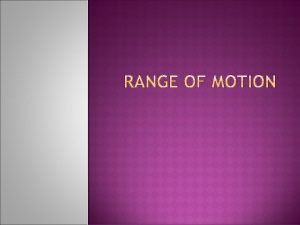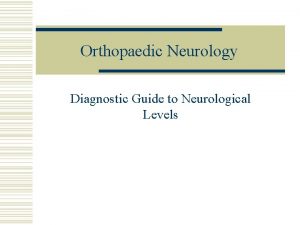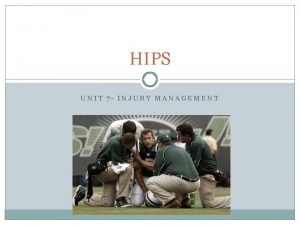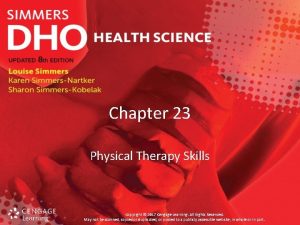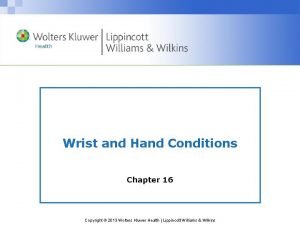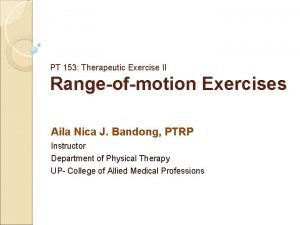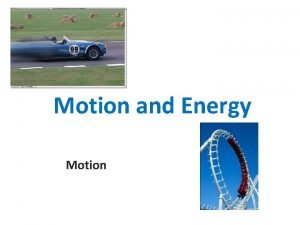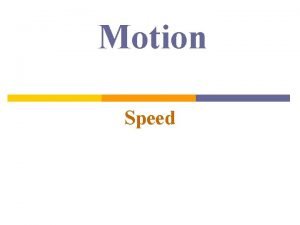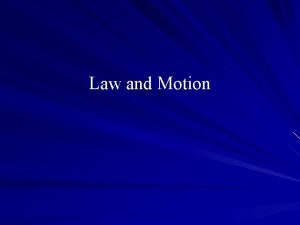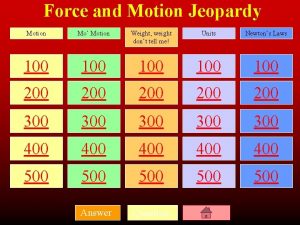Range Of Motion Range Of Motion What is


















- Slides: 18

Range Of Motion

Range Of Motion What is Range Of Motion (ROM)? Normally a joint can move in a particular direction and to a certain limit of motion based on the joint structure itself. ROM is the movement of a joint to the extent possible without causing pain.

ROM: Measurements of a person ROM can be done Passively (PROM) or Actively (AROM): PROM: is the amount of motion at a given joint when moved by an outside force. In other words, PROM involves someone else moving a joint for you. AROM: is the amount of movement at a joint reached when a person tightens their own muscles. In other words, AROM means you move a joint through its range of motion without help.

What causes a lack in ROM: Trauma, illness and disease can affect a joints structure and surrounding tissues • If tendons are damaged due to injury or disease – the tendon can not pull to produce movement • Muscle weakness or loss of strength can prevent full movement • Edema, contractures (soft tissue shortening) and scar tissue can cause limitations to movement • Pain is another possible cause of movement limitations.

Pain • Pain or the fear of pain may effect a persons’ willingness to move. • Pay attention to pain, if an athlete is experiencing pain, stop the activity and re-engage with new method. . • If the athlete experiences increased pain, stop and make adaptations to the activity or environment if needed, or, switch up the activity if possible.

Assessing non-verbal signs of pain • Facial grimacing or a frown • Writhing or constant shifting • Groaning or whimpering • Restlessness and agitation • Appearing uneasy or tense, perhaps drawing their legs up or kicking • Guarding the area of pain or withdrawing from touch to that area

While working with someone with limited ROM always: • Provide moral support and encouragement during the activity. • Encourage independence as much as possible. Let the participant try a new activity or movement by themselves. • Ask how you can help. • Often athletes have developed a system that has worked well for them. • Don’t assume each person needs help in the same way.

How ROM can affect a person’s performance in the water How does limited ROM affect an athlete in the water? Think about it. • How do you use your shoulders, elbows, wrists, hands, hips, knees, ankles, feet and other joints while in the water? • If you were unable to rotate your shoulders, how could you paddle out? • If you were unable to extend your elbows, how could you pop up on your board? We are going to go over how to compensate for these limitations in the next few slides

Limited ROM and dressing A person with limited ROM might have difficulty putting on and taking off garments such as rash guards, helmets or PFD. Remember before you help someone, ask if they would like help. Click to the next slide to see how you can help

Ways to help your Athlete • To help someone put on their rash guard of PFD always start with their affected arm. • Rash guard: Help the athlete thread their affected arm through the sleeve. Then pull the shirt over their head. Now have them thread their less affected arm into the other sleeve. • PFD: First place their affected arm through the arm hole. Then place the rest of the PFD behind their body, have them reach for it and put their strong arm into the other arm hole. • You might need to help a athlete buckle their PFD or helmet straps

What to look for while paddling Athlete could be: • Unable to lift their arm over their head or reach their arm forward • Dragging their hands or arms in the water • Making small circles strokes Example of Full ROM

Ways to help your Athlete paddle While out on the water offer assistance: • A two-person kayak or double wave ski is a great way for you to take on more paddling and to give the athlete a break. • As a surf instructor you can hop on your athlete's board and help paddle with them.

Ways to help your athlete paddle Positioning is key: • People with limited ROM might need to change seated positioning often to reduce pain and discomfort. • A chest wedge can reduce neck and lower back strain as well as elevate a athlete’s chest, so they are in a better position for paddling • A great ways to compensate for limited ROM and strength is to use build up handles or other items (ace wrap) so the athlete can hold onto their paddles.

Limited ROM and Popping Up Limited ROM can effect how a person pops up on their surf board. There are many different ways a athlete can pop up. For example if a athlete has limited wrist ROM how could they pop up? Think about it, get creative. Click to the next slide to get an idea

Limited ROM and Popping Up One way they could pop up is…. . While laying on their stomach lay their rest their elbows under their shoulders with their forearms on the board, then to pop up they could press their forearms into the board and lift their head and chest off the board. We will go over many different options for pop ups during your on the job training.

Transfers Someone with limited ROM might have difficulty getting form point A to point B Re-familiarize yourself with Module 5. There are many different ways we can get athlete in and out of the water. When deciding which transfer technique is best give your athlete options, let them have a choice in which method they feel comfortable with.

Ways to help your participant get around • Ask the athlete how you can assist them • When you are on the beach use the Blue Mat Walkway to transport your athlete • Always try and position the athlete so that they will transfer to their stronger side. • If you are required to lift a athlete be sure to have 4 people: • 2 people to lift the participant • 1 to assist with wheelchair, beach chair or pool lift • 1 to assist with lower body as needed Remember this will be explain again and in more detail during your on the job training

Some conditions that effect ROM • Arthritis: osteoarthritis and rheumatoid • Muscular dystrophy • Multiple sclerosis • Cerebral palsy • Spinal cord injury • Traumatic or acquired brain injury • Amputation • Stroke
 As compared to long-range forecasts, short-range forecasts
As compared to long-range forecasts, short-range forecasts Range of motion definition
Range of motion definition Laws of kinematics
Laws of kinematics Extension lag
Extension lag Range of motion active and passive
Range of motion active and passive Ankle range of motion goniometer
Ankle range of motion goniometer Chapter 23:1 performing range of motion exercises
Chapter 23:1 performing range of motion exercises Range of motion exercise
Range of motion exercise Normal range for elbow extension
Normal range for elbow extension Kiloh nevin sign
Kiloh nevin sign Range of motion types
Range of motion types Passive and active rom
Passive and active rom Active assistive range of motion definition
Active assistive range of motion definition Range of motion active and passive
Range of motion active and passive Chapter 2 motion section 1 describing motion answer key
Chapter 2 motion section 1 describing motion answer key An object in motion stays in motion
An object in motion stays in motion Simple harmonic motion formula sheet
Simple harmonic motion formula sheet Chapter 1 lesson 2 describing motion answer key
Chapter 1 lesson 2 describing motion answer key Chapter 2 section 1 describing motion answer key
Chapter 2 section 1 describing motion answer key

